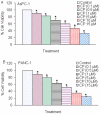EGCG enhances the therapeutic potential of gemcitabine and CP690550 by inhibiting STAT3 signaling pathway in human pancreatic cancer
- PMID: 22348037
- PMCID: PMC3278426
- DOI: 10.1371/journal.pone.0031067
EGCG enhances the therapeutic potential of gemcitabine and CP690550 by inhibiting STAT3 signaling pathway in human pancreatic cancer
Abstract
Background: Signal Transducer and Activator of Transcription 3 (STAT3) is an oncogene, which promotes cell survival, proliferation, motility and progression in cancer cells. Targeting STAT3 signaling may lead to the development of novel therapeutic approaches for human cancers. Here, we examined the effects of epigallocathechin gallate (EGCG) on STAT3 signaling in pancreatic cancer cells, and assessed the therapeutic potential of EGCG with gemcitabine or JAK3 inhibitor CP690550 (Tasocitinib) for the treatment and/or prevention of pancreatic cancer.
Methodology/principal findings: Cell viability and apoptosis were measured by XTT assay and TUNEL staining, respectively. Gene and protein expressions were measured by qRT-PCR and Western blot analysis, respectively. The results revealed that EGCG inhibited the expression of phospho and total JAK3 and STAT3, STAT3 transcription and activation, and the expression of STAT3-regulated genes, resulting in the inhibition of cell motility, migration and invasion, and the induction of caspase-3 and PARP cleavage. The inhibition of STAT3 enhanced the inhibitory effects of EGCG on cell motility and viability. Additionally, gemcitabine and CP690550 alone inhibited STAT3 target genes and synergized with EGCG to inhibit cell viability and induce apoptosis in pancreatic cancer cells.
Conclusions/significance: Overall, these results suggest that EGCG suppresses the growth, invasion and migration of pancreatic cancer cells, and induces apoptosis by interfering with the STAT3 signaling pathway. Moreover, EGCG further enhanced the therapeutic potential of gemcitabine and CP690550 against pancreatic cancer.
Conflict of interest statement
Figures








Similar articles
-
Epigallocatechin-3-Gallate (EGCG) Suppresses Pancreatic Cancer Cell Growth, Invasion, and Migration partly through the Inhibition of Akt Pathway and Epithelial-Mesenchymal Transition: Enhanced Efficacy when Combined with Gemcitabine.Nutrients. 2019 Aug 9;11(8):1856. doi: 10.3390/nu11081856. Nutrients. 2019. PMID: 31405071 Free PMC article.
-
Signal Transducer and Activator of Transcription 3, Mediated Remodeling of the Tumor Microenvironment Results in Enhanced Tumor Drug Delivery in a Mouse Model of Pancreatic Cancer.Gastroenterology. 2015 Dec;149(7):1932-1943.e9. doi: 10.1053/j.gastro.2015.07.058. Epub 2015 Aug 7. Gastroenterology. 2015. PMID: 26255562 Free PMC article.
-
Antitumor activity and combined inhibitory effect of ceritinib with gemcitabine in pancreatic cancer.Am J Physiol Gastrointest Liver Physiol. 2020 Jan 1;318(1):G109-G119. doi: 10.1152/ajpgi.00130.2019. Epub 2019 Nov 18. Am J Physiol Gastrointest Liver Physiol. 2020. PMID: 31736340
-
STAT3 Inhibitors: A Novel Insight for Anticancer Therapy of Pancreatic Cancer.Biomolecules. 2022 Oct 9;12(10):1450. doi: 10.3390/biom12101450. Biomolecules. 2022. PMID: 36291659 Free PMC article. Review.
-
Natural STAT3 Inhibitors for Cancer Treatment: A Comprehensive Literature Review.Recent Pat Anticancer Drug Discov. 2024;19(4):403-502. doi: 10.2174/1574892818666230803100554. Recent Pat Anticancer Drug Discov. 2024. PMID: 37534488 Review.
Cited by
-
Effect of epigallocatechin-3-gallate on tumor necrosis factor-alpha production by human gingival fibroblasts stimulated with bacterial lipopolysaccharide: An in vitro study.J Indian Soc Periodontol. 2021 Jan-Feb;25(1):11-16. doi: 10.4103/jisp.jisp_323_20. Epub 2021 Jan 7. J Indian Soc Periodontol. 2021. PMID: 33642735 Free PMC article.
-
Flavonoids in Cancer and Apoptosis.Cancers (Basel). 2018 Dec 28;11(1):28. doi: 10.3390/cancers11010028. Cancers (Basel). 2018. PMID: 30597838 Free PMC article. Review.
-
Molecular interactions between (-)-epigallocatechin gallate analogs and pancreatic lipase.PLoS One. 2014 Nov 3;9(11):e111143. doi: 10.1371/journal.pone.0111143. eCollection 2014. PLoS One. 2014. PMID: 25365042 Free PMC article.
-
Docosahexaenoic acid inhibits 12-O-tetradecanoylphorbol-13- acetate-induced fascin-1-dependent breast cancer cell migration by suppressing the PKCδ- and Wnt-1/β-catenin-mediated pathways.Oncotarget. 2016 May 3;7(18):25162-79. doi: 10.18632/oncotarget.7301. Oncotarget. 2016. PMID: 27036017 Free PMC article.
-
ErbB Proteins as Molecular Target of Dietary Phytochemicals in Malignant Diseases.J Oncol. 2017;2017:1532534. doi: 10.1155/2017/1532534. Epub 2017 Feb 13. J Oncol. 2017. PMID: 28286519 Free PMC article. Review.
References
-
- Schindler C, Darnell JE. Transcriptional Responses to Polypeptide Ligands: The JAK-STAT Pathway. Annual Review of Biochemistry. 1995;64:621–652. - PubMed
-
- Darnell J, Kerr I, Stark G. Jak-STAT pathways and transcriptional activation in response to IFNs and other extracellular signaling proteins. Science. 1994;264:1415–1421. - PubMed
-
- Darnell JE. STATs and Gene Regulation. Science. 1997;277:1630–1635. - PubMed
-
- Darnell JE., Jr Transcription factors as targets for cancer therapy. Nat Rev Cancer. 2002;2:740–749. - PubMed
Publication types
MeSH terms
Substances
Grants and funding
LinkOut - more resources
Full Text Sources
Other Literature Sources
Medical
Research Materials
Miscellaneous

